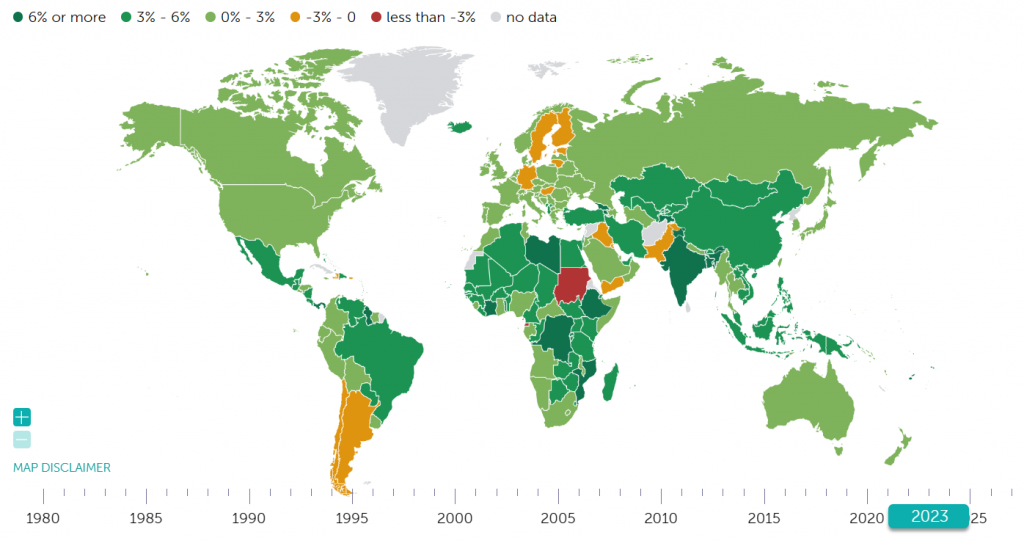
The Indian economy is poised for significant growth in 2023 and 2024, says the latest projections by the International Monetary Fund. The October update of IMF’s World Economic Outlook reveals that India’s economy is expected to expand 6.3% in 2023, an upward revision from its previous estimate of 6.1%. The Fund’s assessment is in line with the optimism among economists, based on various factors that are fuelling India’s economic rise. However, alongside the optimism, there are also a series of challenges that require careful consideration and strategic planning.
One of the pivotal drivers of India’s economic resurgence is its robust domestic consumption. Rising incomes and employment opportunities have led to an increased appetite for goods and services among Indian consumers. This trend serves as the bedrock of the country’s economic vitality. Consumer spending remains a dynamic growth engine, not only for India but also for the global economy, as India’s consumer market is on track to become the world’s third largest by 2027. The rapid expansion of middle to high-income households is a testament to India’s growing middle class, which is driving consumption and bolstering economic growth.
READ I Unemployment puzzle: NSSO data reveals opportunities and challenges
Indian economy on the rise
The Indian government has displayed a strong commitment to driving economic development through substantial investments in infrastructure and social sectors. These investments are expected to have a transformative impact on the country’s economic landscape. The infusion of capital into critical sectors such as transportation, healthcare, education, and technology promises to create jobs, improve living standards, and enhance productivity. It is these investments that are laying the foundation for sustained growth and a higher quality of life for Indian citizens.
Real annual GDP growth rate (%)

World Economic Outlook Growth Projections

India’s export sector has been a key contributor to its economic expansion. The country’s ability to compete in the global marketplace, coupled with strong global demand for Indian goods and services, has created a favourable environment for export growth. India’s export sector is multifaceted, encompassing industries such as information technology, pharmaceuticals, textiles, and automobiles. With a focus on quality and innovation, Indian businesses are poised to capitalise on the opportunities presented by the global market, further bolstering the nation’s economic prospects.
The gathering storms
Despite the positive outlook, India is not immune to the complex challenges that could impede its growth trajectory. Several factors cast shadows over the country’s economic prospects.
Geopolitical tensions on the global stage present a significant risk to India’s economic stability. Recent events, such as rising tensions between India and Canada and the conflict between Israel and Hamas, have led to abrupt spikes in oil prices. Given that India imports more than 80% of its oil consumption, higher energy costs can adversely affect the country’s trade balance, fiscal deficits, inflation, and overall economic growth.
Inflationary pressures have been on the rise in India in recent months. This trend has the potential to erode the purchasing power of households and hinder economic activity. Additionally, a widening current account deficit poses a challenge to India’s economic stability, requiring vigilant management.
India’s vulnerability to extreme weather events, such as heatwaves and droughts, presents a substantial risk to the agricultural sector. These events can disrupt food production and rural recovery efforts, exacerbating economic challenges.
Policy recommendations to boost growth
To navigate these challenges and sustain India’s economic growth, the IMF offers a set of policy recommendations. The Reserve Bank of India should continue its vigilant management of inflation and financial stability. A balanced monetary policy is essential to mitigate inflationary pressures.
The government should persist in investing in infrastructure and social sectors, fostering economic growth while ensuring fiscal sustainability. These investments are crucial for long-term development and job creation.
Structural reforms aimed at improving the business environment and enhancing productivity should remain a priority. These reforms will not only boost economic efficiency but also attract more foreign investments, which are vital for India’s continued growth.
India’s economic prospects appear promising, with strong growth forecasts and a multitude of opportunities on the horizon. However, the path forward is not without its challenges, including geopolitical tensions, inflation, and environmental risks. India’s ability to navigate these headwinds hinges on its commitment to sound economic policies, continued structural reforms, and its capacity to attract foreign investments. As a bright spot in the global economic landscape, India’s ongoing growth story holds immense potential, but it requires proactive measures to realize its full potential and secure a prosperous future for its citizens.
